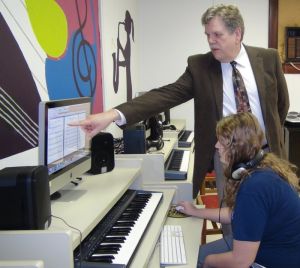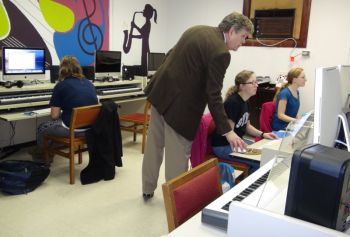
SMWC students compose and analyze music compositions in the College’s newly upgraded music technology lab.
Opening the doors to Saint Mary-of-the-Woods College’s (SMWC) Conservatory of Music, the warm notes of an oboe escape, speckled with the fluttery chirps of a clarinet. Ascending the marble stairs, more and more sounds fill the air– pianos, harps, violins, guitars. Fully suspecting to find an entire orchestra just around the corner, instead you discover one young woman, with her hands on a keyboard and her eyes on the massive screen of an iMac. Listening to the playback of her first full orchestral composition, she stops the music, shaking her head, and with a quick click of the mouse, changes the entire sound.
“I’m a hands-on, visual person,” said Shelby Partin, a sophomore music education major from Indianapolis, Ind. “Being able to play back what you put in helps defeat that margin of human error.”
Perched in the newly updated music technology lab at SMWC, Partin plays “Amazing Grace,” or, rather, the computer performs the arrangement she recorded a few hours earlier. “You can write music for instruments you’ve never played or even seen,” she explained. “Then you can hear how it is supposed to sound.”

John McIntyre, D.M.A., helps student Shelby Partin input the notes for an orchestra.
Thanks to a $7000 grant from the Westerman Foundation, SMWC students are no longer walking into a classroom; they are walking into a state-of-the-art recording studio. Here, they navigate the complex nature of music with innovative software, keyboard workstations, 27” iMac computers and AVID Pro audio recording tools.
“This upgrade provides us with the hardware and software most widely used in the music industry, whether the area is music therapy, or arranging, performing or teaching,” said John McIntyre, D.M.A., associate professor of music at SMWC.
Using the main software, Finale, students can compose original music, arrange scores for a full orchestra and analyze compositions. By recording their own instruments with the AVID pro tools, Finale can even translate their piece into sheet music in real time. Each workstation is connected to a keyboard, but notes can be placed with the click of a mouse, too. “Our music majors will leave here able to notate publication-quality music and to record and produce songs,” McIntyre said.

John McIntyre, D.M.A., shows his class ways to upload notes for different instruments in Finale.
The lab’s previous technology no longer exposed students to equipment used in most up-to-date studios. McIntyre pursued the grant, hoping to give his students the edge needed to compete for the best jobs in the music industry. “Whether our students will work as employees or musical entrepreneurs, up-to-date technical savvy is critical,” McIntyre said. “Thanks to the Westerman Foundation and funding from the College and music department, we were able to go ‘first cabin,’” he said.
Currently, more than 10 courses are taking advantage of the upgrades, but word is spreading around campus quickly. From classes in music theory to music history, McIntyre even foresees online students being able to utilize the new equipment through Desire2Learn, the virtual classroom for Woods Online. “Our iMacs have built-in webcams, so some campus/distance tutoring and mentoring might be on the way,” McIntyre said. “There are so many possibilities.”
Since the upgrade around the beginning of the year, Partin has arranged a gauntlet of scores from common songs, like “Oh Susannah,” to the complicated whirlwinds of Mozart. A flute player for eight years, an entire world of new and intriguing instruments, like the Hawaiian ka’eke’eke, is just a click away. She is discovering how different instruments interact in an ensemble without having to know how to play them all. Partin has even created her own unique compositions, a virtual orchestra that could rival the Boston Philharmonic. “It’s an engaging way to learn music and I’ve been having a lot of fun with it,” she said. “I bet Mozart wished he had this lab.”
Interested in learning more? Visit SMWC’s Department of Music and Theatre online!
